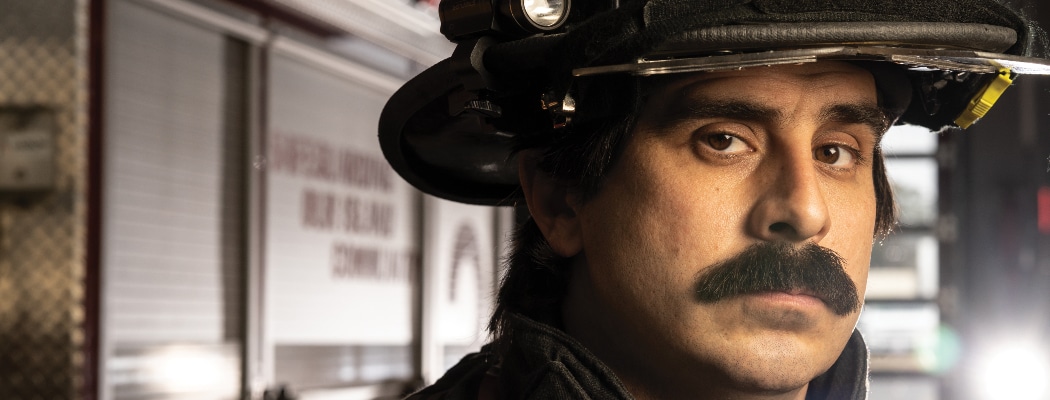Nantucket Fire Department brings safety to national attention.
It has long been said that only a certain kind of person is willing to run toward danger to save another, but at the Nantucket Fire Department (NFD), a brave union of the more than thirty men and women have each other’s backs beyond the blazes and business of the fire service. They are a family forged by a calling to community and service, one that recognizes that when one suffers, they all suffer, and that when they take a stand, together they can move mountains.

The NFD recently entered the national spotlight in a January 26th article of The New York Times that featured Captain Sean Mitchell’s account of how the department has taken on big business to reclaim firefighter safety. In recent years, studies have revealed that the protective equipment firefighters rely on so heavily is also likely responsible for some previously unknown dangers. This fire-retardant clothing known commonly as turnout gear has been engineered over time to protect firefighters from heat and flames, but after decades of research, it is now apparent that this gear also leaches cancer-causing chemicals into clothing and skin.
“Cancer is a problem in the fire service,” said Mitchell, a firefighter with the department since 2006. “I saw a film in 2016 that covered the high incidence of cancers in the Boston Fire Department, then I decided to take a class about the issue at the Mass Fire Academy.” As a full-time firefighter with a family, Mitchell found the data concerning, but, he said, it didn’t really hit home until one of Nantucket’s own got a diagnosis in the fall of 2019.
“I was diagnosed with seminoma, a form of testicular cancer,” said Captain Nate Barber, who at age thirty-nine is a career firefighter and vice president of the local firefighter’s union. “I got it most likely from being a member of the fire service and being exposed to dangerous chemicals as a result of doing our job.”
The transgressor: toxic chemical compounds and fire retardants known as PFAS (per- and polyfluoroalkyl substances). Conventional wisdom for decades implied that these chemicals were trapped within the layers of the gear, but data has proven that firefighters are twice as likely to be diagnosed with forms of testicular and kidney cancer, as well as an array of other maladies and illnesses, said Barber.
“When Nate got sick it was a real slap in the face,” Mitchell said. “We all knew his cancer was linked to these chemicals, and it was at that time I decided to investigate further and that’s how we ended up where we are today.”

Because of his friend’s diagnosis, Mitchell has taken on this challenge on behalf of the department to identify these dangers industry-wide and has worked with colleagues across the country to provide safe alternatives for fire service families everywhere. The only problem: These safe alternatives don’t exist yet, at least not to scale. While several innovative companies have come up with alternative solutions, they have not been adequately produced to date and are very expensive.

Barber—whose cancer is now in remission and who is back to work—hopes his cancer is in the past but also recognizes that the issues he and his fellow firefighters face are still ongoing. “I’m doing well. I’m on the path to recovery and on the five-year plan for checkups; it’s looking positive,” he said. “But I do want to say what Sean is doing is very remarkable because he’s going up against very powerful corporations and he’s winning. He might be the most important firefighter in this country right now. He’s taking on corporations that are poisoning the world and he’s making a big difference to every firefighter in this country. He’s taking on an entire industry to effect change. He’s doing it for a lot of people, but in a way, as my friend, I feel like he’s doing it for me.”
Supporting Mitchell’s efforts from day one, NFD Chief Stephen Murphy turned to the Town, which was very cooperative and eager to correct the problem. NFD received $150,000 in July 2020 to acquire new, safer gear. While some sets of new gear have arrived and are in circulation, other sets are still in production, requiring the department to continue wearing its compromised gear and using safe storage and other protocols to mitigate risk.
A Nantucket native and career firefighter on the island, Murphy leads what he describes as a modern fire service focused on safety and efficiency for both the citizens they defend and for his firefighters. Turnout gear is just one aspect of keeping members of the NFD safe on the job. Regular training and continuing education are a constant for Nantucket’s firefighters with their new facility at the Town’s safety complex on Fairgrounds Road.

“Safety is accomplished through training and providing our people with all the equipment necessary to do their jobs,” said Murphy, who said staff will soon be training with a new advanced life support system in ambulances that will substantially improve the prospects of those critically injured in the field. Murphy is a product of childhood enthusiasm for the fire service having been funneled into a junior firefighter program at a young age, one that the NFD has continued at times throughout the years and has helped shape a cohesive and committed department.
“We’ve been trying really hard for a long time now to create a department that’s invested in Nantucket,” said Murphy, who has been chief since 2017 after being a long-term assistant and interim chief. “Half our department was born here, and I think we have a team that understands what it takes to live here and be a part of the community they serve.”
Brandon Eldridge, another native and product of the junior firefighter program, has served the department for the past eighteen years as an on-call firefighter. “They called it the explorer program when I was in my teens,” he said. “When I turned 18, I knew I had fallen in love with the service and knew it was a way I could help people.”

Beyond attracting homegrown talent committed to long careers on Nantucket, Murphy recognizes that a strong department is one that captures talent no matter where it may come from. For instance, one of the most recent additions to the NFD’s ranks, twenty-nine-year-old Alana Macey, originally hails from a suburb outside Sydney, Australia, where she had worked as an EMT since 2012. After relocating to the island full-time by 2019, Macey began the arduous process of getting recertified in the United States and beginning her career in her new home. Having long been focused on her passion for the medical aspects of her job, Macey said that training to become a full-time firefighter has been a welcome challenge, one made more interesting by the COVID-19 pandemic. “It’s always been my goal to work in medicine and the EMT service, but it’s been so cool to learn this whole new skill and serve the community in a greater way,” she said.

The fire service has always been a profession laden with risk, to be sure, but it’s also one that’s defined by the details with the ultimate goal of prevention, said Murphy. As the size and needs of the Nantucket community have changed over the years, so have those of the department. Today, with the island’s year-round population close to 20,000, and seasonal peaks touching nearly 50,000, the NFD keeps watch on twenty-four-hour shifts with at least twenty-six full-time firefighters and certified EMTs. Another twenty serve the department in an on-call capacity, as well as six in support roles and administration, which include Murphy and Assistant Chief Robert Bates.
First documented in 1750, the fire service on Nantucket was created out of need as the island was the center of the global whaling industry. By the late 1800s, the department was equipped with an array of firefighting apparatus, and more than two hundred men on Nantucket served as volunteer firefighters. In 1929, the department moved into the red-brick station at 20 South Water Street, in the heart of downtown Nantucket (now the county sheriff’s office). In 1980, it moved mid-island to upper Pleasant Street and stayed there until voters approved a new station in 2015 as part of the Town’s public safety complex on Fairgrounds Road where the department resides today. Training amenities that were never available to the department before now include a full gym and training tower that allows firefighters to traverse a five-story flight of stairs with gear.
Today’s Nantucket Fire Department is a hub of activity every single day of the year, no matter the season, said Murphy. In the relative quiet of the winter months, alarms and emergency calls are common throughout the days and nights, while the summer is a constant cacophony of activity with multiple fire and EMT crews responding to an array of calls at any given time. In 2020 alone, the department responded to twenty-two building fires, eighteen outdoor fires, thirty illegal beach/bonfires, a landfill fire, five airport alerts, seven car fires, four transformer fires, forty-three reported gas leaks and 1,509 fire alarms. Firefighters and EMTs responded to 847 emergency 911 phone calls and thirty-one vehicle crashes, and participated in 157 MedFlight transports and 124 medical transports. That’s not to mention the hundreds of other calls for a variety of emergency and fire prevention needs the department receives every year.

All these statistics magnify the department’s need to maintain the high standards and responsiveness of a small force on an isolated island, which brings many in the department back to the need to operate as part of a cohesive unit. “For me, I was drawn in because of the team aspect of things,” said Alex Rezendes, a fifth-year firefighter. “I’ve always played team sports, and the idea of being a part of this team was something I wanted to do, and it was a way to give back to the town that I’m from.”
News of this team spirit on Nantucket and the movement to effect real change in the industry that was profiled by The New York Times has since spread far and wide. Just days after the Times published its story, the International Association of Fire Fighters passed a resolution to stop accepting funds and sponsorships from the major corporations producing dangerous gear. As reported in the Times, a suit was filed last October against 3M, Chemours, E.I. du Pont de Nemours and other manufacturers for the presence of PFAS in their products. In April, the NFD announced that five of its members were among the first in the country to wear gear that has a PFAS-free outer shell, proving once again that our fire house on Nantucket is leading the nation in fire safety.






